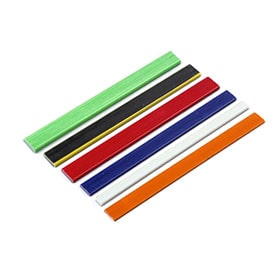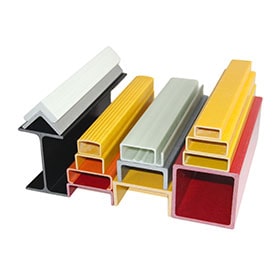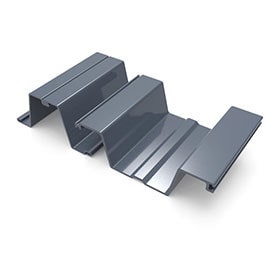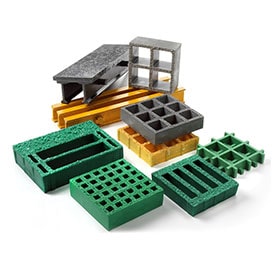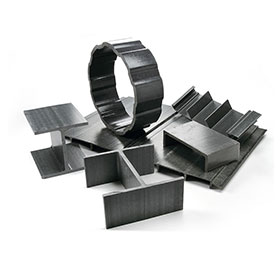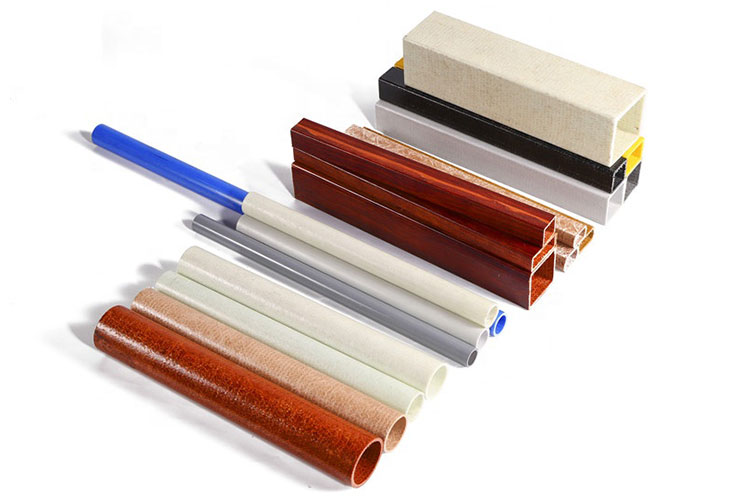
fiberglass profiles
Factors Determining the Strength of Fiberglass Profiles — A Deep Technical Analysis
Fiberglass profiles (FRP pultruded profiles) are widely used in construction, infrastructure, chemical plants, marine engineering, power systems, and transportation due to their high strength-to-weight ratio, corrosion resistance, and long service life. However, the mechanical strength of FRP is not a fixed characteristic — it is the result of a complex interaction between materials, structural design, processing technology, and long-term service environments.
Understanding what truly determines the strength of fiberglass profiles is essential for engineers, buyers, and manufacturers who aim to achieve predictable, stable, and durable product performance. This article provides a deep and comprehensive analysis from the perspective of composite mechanics, pultrusion engineering, and material science.
1. Reinforcement Fiber: The Primary Source of Load-Bearing Strength
In FRP composites, fiber carries 70–80% of the mechanical load, making it the single most important factor influencing profile strength.
1.1 Fiber Type
| Fiber Type | Tensile Strength | Tensile Modulus | Cost | Applications |
|---|---|---|---|---|
| E-glass | Medium | Medium | Low | General construction, gratings |
| S-glass | Very High | High | Medium | Aerospace, high-load structural parts |
| Carbon fiber | Extremely High | Very High | High | Bridges, strengthening systems |
| Basalt fiber | High | Medium–High | Medium | Anti-corrosion, high-temperature use |
For most pultruded profiles, E-glass rovings provide a balanced cost-performance ratio, while S-glass or carbon fiber is used when stiffness or strength requirements exceed the limits of E-glass.
1.2 Fiber Volume Fraction (FVF)
FVF generally ranges between 45%–70% in pultruded FRP. Higher FVF means higher tensile and flexural strength. However:
- Too low FVF → weak load-bearing capability
- Too high FVF → poor resin infiltration, more voids, and increased brittleness
A well-optimized pultrusion process should maintain stable and uniform FVF along the entire profile length.
1.3 Fiber Orientation
Fiber orientation determines anisotropy:
- Unidirectional rovings (0°) → maximum tensile strength along the length
- Woven rovings (±45° or 90°) → shear and transverse strength
- Surface mats (random orientation) → improve surface finish & protect fibers
Structural profiles such as channels, I-beams, and tubes require optimized multi-directional fiber architecture to handle bending, torque, buckling, and local stress.
2. Resin System: The Matrix That Binds and Protects Fibers
Resin does not primarily carry load, but it determines toughness, durability, adhesion strength, chemical resistance, and environmental stability.
2.1 Resin Types
- Polyester resin — economical, suitable for standard applications
- Vinyl ester resin — excellent corrosion, fatigue, and crack resistance
- Epoxy resin — strongest bonding and lowest shrinkage, ideal for ultra-high-strength profiles
- Phenolic resin — excellent fire resistance
Resin quality directly affects:
- Interlaminar shear strength (ILSS)
- Fatigue life
- Crack propagation resistance
- Heat distortion temperature (HDT)
2.2 Resin Curing Characteristics
Resin must be precisely cured:
- Under-cure → soft, low strength, poor chemical resistance
- Over-cure → brittle, internal stress, micro-cracks
Temperature profile and dwell time in the heated die determine crosslink density, thermal stability, and mechanical consistency.
3. Interface Bonding: The Invisible but Critical Strength Factor
In composite mechanics, the fiber–matrix interface is crucial. A strong interface produces higher shear strength, better stress transfer, and increased fatigue resistance. A weak interface results in fiber pull-out, delamination, and reduced bending strength.
Coupling agents such as silane-based treatments improve bonding and stability under humidity and chemical exposure.
4. Manufacturing Process: Pultrusion Technology Determines Consistency
Pultrusion is a continuous process — strength is highly affected by production quality.
4.1 Resin Impregnation Quality
Good impregnation ensures:
- No dry fibers
- Low void content
- Homogeneous resin distribution
Voids above 1–2% can massively reduce tensile strength and are often invisible without ultrasound testing.
4.2 Pultrusion Speed
Speed must match resin reactivity:
- Too fast → incomplete cure, internal voids
- Too slow → excessive energy consumption, resin overcure
Advanced manufacturers use closed-loop control systems to stabilize curing and maintain consistency.
4.3 Die Temperature & Curing Curve
Strength depends on die temperature uniformity, heated zone length, and pressure distribution. High-end molds (such as those produced by Henan Zhongsheng) ensure accurate dimensions, smooth surfaces, and low stress concentration.
5. Profile Geometry & Structural Design
Mechanical strength is also determined by the structural moment of inertia (I). For example:
- I-beams are stronger in bending than flat plates
- Tubes resist torsion better due to closed sections
- Thickened corners reduce fracture risk
Design flaws such as sudden thickness transitions can cause stress concentration, micro-crack initiation, and premature structural failure. FEM (finite element modeling) is an advanced method to evaluate FRP structural behavior.
6. Additives and Fillers: Not Just Optional Materials
Additives affect multiple performance features:
- UV stabilizers → prevent yellowing and degradation
- Fire retardants → improve safety
- Fillers (CaCO₃, ATH) → influence stiffness, cost, and corrosion resistance
Improper filler ratios lower strength and increase brittleness.
7. Service Environment: Long-Term Strength Depends on Conditions
7.1 UV Exposure
UV radiation causes resin chain scission, surface cracking, and color fading. UV-resistant coatings or VE resin help extend service life.
7.2 Temperature Changes
Extreme heating or cooling affects thermal expansion mismatch, micro-cracking, and resin softening.
7.3 Chemical Exposure
FRP may degrade in strong acids, organic solvents, or high-pH environments. Proper resin selection is essential for chemical resistance.
7.4 Moisture Absorption
Moisture affects the fiber–matrix interface, dimensional stability, and fatigue behavior. Vinyl ester and epoxy have the lowest moisture uptake.
8. Quality Inspection: Ensuring High Strength and Consistency
Reliable FRP strength depends on strict quality control:
- Tensile strength test (ASTM D638)
- Flexural strength test (ASTM D790)
- Interlaminar shear (ILSS) test
- Barcol hardness
- Fiber content & orientation analysis
- Microscopy & void inspection
- Fatigue test for structural profiles
Top manufacturers implement automated online monitoring systems to maintain stable mechanical performance.
Conclusion
The strength of fiberglass pultruded profiles is the result of a multi-factor system:
- High-quality fibers
- Proper resin selection
- Strong interfacial bonding
- Stable pultrusion process
- Scientific structural design
- Optimized additives and protective systems
- Controlled service environment
By understanding these factors, engineers and buyers can make informed decisions to ensure long-term reliability and cost efficiency. Henan Zhongsheng specializes in manufacturing FRP profiles, pultrusion molds, and pultrusion equipment with a strong focus on stability, mechanical performance, and durability.
Email: Jessica@frpzs.com
WhatsApp: +86 15303735673
Website: www.frpzs.com
 +86 15303735673
+86 15303735673 Jessica@frpzs.com
Jessica@frpzs.com
 Technical Data
Technical Data




